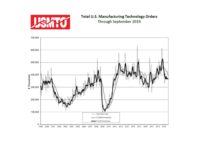INDUSTRY HEADLINE
U.S. Manufacturing Sees Solid Growth in May
WASHINGTON D.C.—The Institute for Supply Management twice corrected its May manufacturing index on Monday to show that factories grew at a strong pace during the month. The original report said that manufacturers had expanded at a weaker pace.
The index, a widely followed gauge of factory activity, now reads 55.4, up from 53.2 in the initial report. Any reading above 50 indicates expansion.
The corrected figures indicate that manufacturing is expanding at a healthy pace and should help the economy rebound after a weak start to the year. Nearly all of the 18 industries tracked by the index reported growth, led by furniture, electrical equipment, and appliances. Textiles, the only sector that didn't grow, were flat.
"They say that the third time is the charm," said Paul Ashworth, an economist at Capital Economics, in a research note. "Let's hope so for the ISM's sake... Based on the corrected survey, it appears that manufacturing activity is still gathering momentum."
Wall Street rebounded from early losses after the ISM, a trade group of purchasing managers, issued its corrections. The Dow Jones industrial average rose 12 points in afternoon trading, though broader indexes slipped.
The ISM data is one of a few economic reports that can fuel sharp movements in stock market indexes. Major revisions to such a closely watched economic report on the day of release are highly unusual, traders said.
Measures of production and orders in May rose to healthy levels. The production index surged to 61 from 55.7 in April. And a gauge of orders increased to 56.9, up from 55.1 in April. Both figures were the highest since December. Rising orders suggests that factory output should remain strong in the coming months.
A measure of employment showed that factories added jobs in May, though at a slower pace than the previous month. That could weigh on last month's overall job gains. The government will issue May's jobs report on Friday.
Prices paid by manufacturers jumped, a sign that factories are spending more for raw materials such as steel, plastics and aluminum. If companies pass on those costs, that could lift inflation in the coming months.
A measure of export orders dipped, reflecting weak growth in Europe and a slowdown in China. But factories are showing signs of life in the world's No. 2 economy: A separate manufacturing index released by China Monday rose to 50.8 in May, its highest level this year.
Other recent U.S. manufacturing data has been mixed.
Factory output fell in April as manufacturers produced less furniture, machinery and plastics, according to a recent Federal Reserve report. The drop followed two months of strong gains, and economists said it was likely temporary.
U.S. factories received more orders for long-lasting goods in April, the Commerce Department said last week. But the increase occurred because of a surge in demand for military aircraft. Excluding defense-related goods, orders actually fell.
And orders for core capital goods, a category viewed as a proxy for business investment plans, fell 1.2 percent in April. It was the weakest showing since a 1.9 percent January drop.
Looking for a reprint of this article?
From high-res PDFs to custom plaques, order your copy today!







